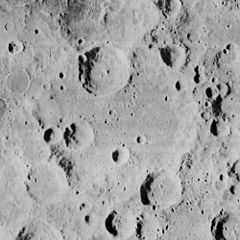Hirayama (crater)
|
Lunar Orbiter 2 image | |
| Coordinates | 6°06′S 93°30′E / 6.1°S 93.5°ECoordinates: 6°06′S 93°30′E / 6.1°S 93.5°E |
|---|---|
| Diameter | 132 km |
| Depth | Unknown |
| Colongitude | 268° at sunrise |
| Eponym |
Kiyotsugu Hirayama Shin Hirayama |

Hirayama is a large lunar crater that is located on the far side of the Moon, just beyond the eastern limb. This region of the surface is sometimes brought into view from Earth during periods of favourable libration. However it is best viewed from orbit. This crater is located along the southeastern edge of the Mare Smythii, to the northeast of the crater Brunner. To the northeast of Hirayama is Wyld.
This is a worn and eroded crater with multiple impacts overlapping the outer rim and the interior floor. Hirayama K has broken across the rim to the southeast and Hirayama C crosses the northeastern rim. Along the southwestern outer edge is Hirayama Q. The small Hirayama T is located along the western inner wall, and attached to its eastern edge is Hirayama S. The crater Hirayama Y is adjacent to the northern inner walls of Hirayama and covers a significant part of the northern interior floor. Several smaller craters lie within the floor, including Hirayama N in the south. The floor otherwise forms a relatively level surface within the inner wall.
Satellite craters
By convention these features are identified on lunar maps by placing the letter on the side of the crater midpoint that is closest to Hirayama.
| Hirayama | Latitude | Longitude | Diameter |
|---|---|---|---|
| C | 4.2° S | 95.4° E | 23 km |
| F | 5.8° S | 97.2° E | 35 km |
| G | 6.4° S | 96.8° E | 18 km |
| K | 8.3° S | 94.9° E | 39 km |
| L | 9.4° S | 94.4° E | 24 km |
| M | 9.2° S | 93.5° E | 29 km |
| N | 7.2° S | 93.6° E | 17 km |
| Q | 8.0° S | 91.3° E | 40 km |
| S | 6.5° S | 92.3° E | 29 km |
| T | 6.4° S | 91.5° E | 18 km |
| Y | 4.5° S | 93.2° E | 50 km |
References
- Andersson, L. E.; Whitaker, E. A. (1982). NASA Catalogue of Lunar Nomenclature. NASA RP-1097.
- Blue, Jennifer (July 25, 2007). "Gazetteer of Planetary Nomenclature". USGS. Retrieved 2007-08-05.
- Bussey, B.; Spudis, P. (2004). The Clementine Atlas of the Moon. New York: Cambridge University Press. ISBN 978-0-521-81528-4.
- Cocks, Elijah E.; Cocks, Josiah C. (1995). Who's Who on the Moon: A Biographical Dictionary of Lunar Nomenclature. Tudor Publishers. ISBN 978-0-936389-27-1.
- McDowell, Jonathan (July 15, 2007). "Lunar Nomenclature". Jonathan's Space Report. Retrieved 2007-10-24.
- Menzel, D. H.; Minnaert, M.; Levin, B.; Dollfus, A.; Bell, B. (1971). "Report on Lunar Nomenclature by the Working Group of Commission 17 of the IAU". Space Science Reviews 12 (2): 136–186. Bibcode:1971SSRv...12..136M. doi:10.1007/BF00171763.
- Moore, Patrick (2001). On the Moon. Sterling Publishing Co. ISBN 978-0-304-35469-6.
- Price, Fred W. (1988). The Moon Observer's Handbook. Cambridge University Press. ISBN 978-0-521-33500-3.
- Rükl, Antonín (1990). Atlas of the Moon. Kalmbach Books. ISBN 978-0-913135-17-4.
- Webb, Rev. T. W. (1962). Celestial Objects for Common Telescopes (6th revision ed.). Dover. ISBN 978-0-486-20917-3.
- Whitaker, Ewen A. (1999). Mapping and Naming the Moon. Cambridge University Press. ISBN 978-0-521-62248-6.
- Wlasuk, Peter T. (2000). Observing the Moon. Springer. ISBN 978-1-85233-193-1.
